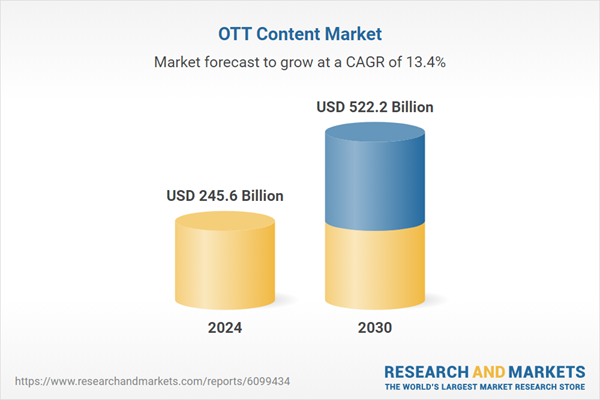Global OTT Content Market - Key Trends & Drivers Summarized
How Is OTT Content Disrupting Traditional Broadcasting and Redefining Viewer Preferences?
Over-the-top (OTT) content - delivered via internet streaming without the involvement of traditional cable or satellite platforms - is rapidly reshaping the global entertainment landscape. With access to vast libraries of on-demand movies, TV shows, web series, documentaries, and regional content, consumers are increasingly turning to digital-first platforms for personalized, anytime-anywhere viewing experiences. This disruption has significantly impacted linear TV consumption, accelerating cord-cutting trends and fueling exponential growth in digital content consumption across all age groups.OTT platforms such as Netflix, Amazon Prime Video, Disney+, and regional players like Zee5, Viu, and iQIYI are leveraging data-driven personalization, multilingual support, and content variety to increase user engagement. As a result, the demand for original programming, exclusive rights, and user-generated content has surged. These platforms are investing heavily in global and hyperlocal productions, targeting diverse demographic cohorts with genre-specific content - ranging from crime thrillers and K-dramas to indie films and educational mini-series. This explosion of creativity, combined with affordability and accessibility, is fundamentally altering how content is produced, distributed, and consumed.
Why Are Subscription Models, Ad-Supported Platforms, and Content Personalization Gaining Momentum?
The OTT ecosystem is diversifying into multiple monetization models, with Subscription Video on Demand (SVOD), Advertising Video on Demand (AVOD), and hybrid Freemium models gaining substantial ground. SVOD platforms like Netflix and Disney+ continue to dominate in premium content delivery, while AVOD models - such as Tubi, Pluto TV, and YouTube - are rapidly expanding in ad-supported markets where price sensitivity is high. These models enable flexible content access across economic strata and support mass market scalability.Content personalization is a major differentiator, powered by AI and recommendation engines that adapt to user behavior, watch history, and preferences. Smart curation, multi-profile user interfaces, and regional language options are enhancing viewer satisfaction and reducing churn. Furthermore, the proliferation of multi-device consumption - across smartphones, tablets, smart TVs, and gaming consoles - is driving cross-platform content optimization. Interactive features such as live chat, alternate endings, gamified content, and real-time viewer polls are also being explored to deepen engagement and create differentiated viewing experiences.
How Are Global Expansion, Regulation, and Technological Infrastructure Shaping Market Maturity?
As OTT platforms seek global market penetration, regional content production and localized user interfaces have become strategic priorities. Investments in vernacular programming, regional talent, and subtitling/dubbing capabilities are helping platforms break into non-English-speaking markets. Strategic partnerships with telecom providers, smart TV manufacturers, and digital payment platforms are further aiding in subscriber acquisition, particularly in rural and tier-2 regions where smartphone penetration is high.However, regulatory challenges are increasing. Content moderation, local censorship laws, data privacy regulations, and licensing compliance are imposing operational complexities, especially in countries like India, China, and parts of the Middle East. Governments are also mandating investment in local content, fair advertising practices, and transparent data usage, compelling OTT players to adapt agile content governance frameworks. Meanwhile, 5G rollouts, edge computing, and content delivery network (CDN) optimization are enhancing streaming quality and reducing latency, enabling seamless delivery of 4K and immersive content formats.
What's Fueling the Unstoppable Growth of the OTT Content Market?
The growth in the OTT content market is driven by several factors including widespread internet penetration, the proliferation of affordable smart devices, changing viewer habits, and evolving digital monetization models. A major driver is the younger generation's preference for on-demand, interactive, and bite-sized content formats, which align with mobile-first and socially integrated consumption behavior. The availability of personalized content at flexible price points has made OTT a preferred medium for entertainment, education, fitness, and even virtual therapy.COVID-19 accelerated OTT adoption by shifting entertainment consumption into the home, catalyzing digital subscription habits across demographic segments. Corporate investments, venture capital funding, and consolidation in the media-tech space have further fueled innovation and competitive expansion. Moreover, the global appetite for diverse storytelling - across cultures, languages, and formats - is encouraging transnational content production and global licensing deals.
As the industry matures, the next growth phase will be driven by interactive content, AR/VR integrations, niche verticals (e.g., anime, sports, edutainment), and hyperlocal monetization strategies. OTT is no longer just a platform - it's becoming the mainstream media infrastructure of the digital age, with limitless content possibilities and unparalleled user reach.
Report Scope
The report analyzes the OTT Content market, presented in terms of market value (US$). The analysis covers the key segments and geographic regions outlined below:- Segments: Revenue Model (Subscription-based, Advertising-based, Transaction-based); Streaming Platform (Desktop & Laptop, Gaming Consoles, OTT Streaming Devices, Smartphones & Tablets, Smart TVs, Other Streaming Platforms).
- Geographic Regions/Countries: World; United States; Canada; Japan; China; Europe (France; Germany; Italy; United Kingdom; Spain; Russia; and Rest of Europe); Asia-Pacific (Australia; India; South Korea; and Rest of Asia-Pacific); Latin America (Argentina; Brazil; Mexico; and Rest of Latin America); Middle East (Iran; Israel; Saudi Arabia; United Arab Emirates; and Rest of Middle East); and Africa.
Key Insights:
- Market Growth: Understand the significant growth trajectory of the Subscription-based Revenue Model segment, which is expected to reach US$322.7 Billion by 2030 with a CAGR of a 12.7%. The Advertising-based Revenue Model segment is also set to grow at 14.4% CAGR over the analysis period.
- Regional Analysis: Gain insights into the U.S. market, valued at $66.9 Billion in 2024, and China, forecasted to grow at an impressive 17.8% CAGR to reach $110.1 Billion by 2030. Discover growth trends in other key regions, including Japan, Canada, Germany, and the Asia-Pacific.
Why You Should Buy This Report:
- Detailed Market Analysis: Access a thorough analysis of the Global OTT Content Market, covering all major geographic regions and market segments.
- Competitive Insights: Get an overview of the competitive landscape, including the market presence of major players across different geographies.
- Future Trends and Drivers: Understand the key trends and drivers shaping the future of the Global OTT Content Market.
- Actionable Insights: Benefit from actionable insights that can help you identify new revenue opportunities and make strategic business decisions.
Key Questions Answered:
- How is the Global OTT Content Market expected to evolve by 2030?
- What are the main drivers and restraints affecting the market?
- Which market segments will grow the most over the forecast period?
- How will market shares for different regions and segments change by 2030?
- Who are the leading players in the market, and what are their prospects?
Report Features:
- Comprehensive Market Data: Independent analysis of annual sales and market forecasts in US$ Million from 2024 to 2030.
- In-Depth Regional Analysis: Detailed insights into key markets, including the U.S., China, Japan, Canada, Europe, Asia-Pacific, Latin America, Middle East, and Africa.
- Company Profiles: Coverage of players such as Abbott Laboratories, Amway Corporation, Bayer AG, Boehringer Ingelheim GmbH, Cipla Limited and more.
- Complimentary Updates: Receive free report updates for one year to keep you informed of the latest market developments.
Some of the 42 companies featured in this OTT Content market report include:
- Amazon Prime Video
- Apple TV+
- Brightcove Inc.
- Dacast Inc.
- Disney+
- HBO Max (Warner Bros. Discovery)
- Hulu LLC
- Kaltura Inc.
- Netflix Inc.
- Paramount+ (Paramount Global)
- Peacock (Comcast Corporation)
- Rakuten Viki
- Roku Inc.
- SonyLIV (Sony Pictures Networks)
- Tencent Video
- ViacomCBS (Paramount Global)
- Vimeo OTT
- Viu (PCCW Media)
- YouTube (Google LLC)
- ZEE5 (Zee Entertainment)
This edition integrates the latest global trade and economic shifts into comprehensive market analysis. Key updates include:
- Tariff and Trade Impact: Insights into global tariff negotiations across 180+ countries, with analysis of supply chain turbulence, sourcing disruptions, and geographic realignment. Special focus on 2025 as a pivotal year for trade tensions, including updated perspectives on the Trump-era tariffs.
- Adjusted Forecasts and Analytics: Revised global and regional market forecasts through 2030, incorporating tariff effects, economic uncertainty, and structural changes in globalization. Includes historical analysis from 2015 to 2023.
- Strategic Market Dynamics: Evaluation of revised market prospects, regional outlooks, and key economic indicators such as population and urbanization trends.
- Innovation & Technology Trends: Latest developments in product and process innovation, emerging technologies, and key industry drivers shaping the competitive landscape.
- Competitive Intelligence: Updated global market share estimates for 2025, competitive positioning of major players (Strong/Active/Niche/Trivial), and refined focus on leading global brands and core players.
- Expert Insight & Commentary: Strategic analysis from economists, trade experts, and domain specialists to contextualize market shifts and identify emerging opportunities.
Table of Contents
Companies Mentioned (Partial List)
A selection of companies mentioned in this report includes, but is not limited to:
- Amazon Prime Video
- Apple TV+
- Brightcove Inc.
- Dacast Inc.
- Disney+
- HBO Max (Warner Bros. Discovery)
- Hulu LLC
- Kaltura Inc.
- Netflix Inc.
- Paramount+ (Paramount Global)
- Peacock (Comcast Corporation)
- Rakuten Viki
- Roku Inc.
- SonyLIV (Sony Pictures Networks)
- Tencent Video
- ViacomCBS (Paramount Global)
- Vimeo OTT
- Viu (PCCW Media)
- YouTube (Google LLC)
- ZEE5 (Zee Entertainment)
Table Information
| Report Attribute | Details |
|---|---|
| No. of Pages | 288 |
| Published | December 2025 |
| Forecast Period | 2024 - 2030 |
| Estimated Market Value ( USD | $ 245.6 Billion |
| Forecasted Market Value ( USD | $ 522.2 Billion |
| Compound Annual Growth Rate | 13.4% |
| Regions Covered | Global |









